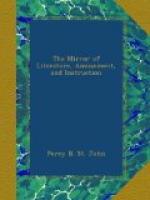Some of the most current of these traditions are so
happily described by the above-mentioned writer, that
we cannot refrain from quoting the passage. “Michael
was chosen,” it is said, “to go upon an
embassy to obtain from the King of France satisfaction
for certain piracies committed by his subjects upon
those of Scotland. Instead of preparing a new
equipage and splendid retinue, the ambassador retreated
to his study, and evoked a fiend, in the shape of
a huge black horse, mounted upon his back, and forced
him to fly through the air towards France. As
they crossed the sea, the devil insidiously asked
his rider what it was that the old women of Scotland
muttered at bedtime. A less experienced wizard
might have answered, that it was the Pater Noster,
which would have licensed the devil to precipitate
him from his back. But Michael sternly replied,
‘What is that to thee? Mount, Diabolus,
and fly!’ When he arrived at Paris, he tied
his horse to the gate of the palace, entered, and boldly
delivered his message. An ambassador with so little
of the pomp and circumstance of diplomacy, was not
received with much respect, and the king was about
to return a contemptuous refusal to his demand, when
Michael besought him to suspend his resolution till
he had seen his horse stamp three times. The
first stamp shook every steeple in Paris, and caused
all the bells to ring, the second threw down three
towers of the palace, and the infernal steed had lifted
his foot to give the third stamp, when the king rather
chose to dismiss Michael with the most ample concessions,
than to stand the probable consequences. Another
time, it is said, when residing at the tower of Oakwood,
upon the Ettrick, about three miles above Selkirk,
he heard of the fame of a sorceress, called the witch
of Falsehope, on the opposite side of the river.
Michael went one morning to put her skill to the test,
but was disappointed, by her denying positively any
knowledge of the necromantic art. In his discourse
with her, he laid his wand inadvertently on the table,
which the hag observing, suddenly snatched it up,
and struck him with it. Feeling the force of
the charm, he rushed out of the house; but as it had
conferred on him the external appearance of a hare,
his servant, who waited without, halloo’d upon
the discomfited Wizard his own hounds, and pursued
him so close, that in order to obtain a moment’s
breathing to reverse the charm, Michael, after a very
fatiguing course, was fain to take refuge in his own
jaw-hole, Anglice, common sewer. In order to
revenge himself of the witch of Falsehope, Michael,
one morning in the ensuing harvest, went to the hill
above the house with his dogs, and sent down his servant
to ask a bit of bread from the goodwife for his greyhounds,
with instructions what to do if he met with a denial.
Accordingly, when the witch had refused the boon with
contumely, the servant, as his master had directed,
laid above the door a paper which he had given him,
containing, amongst many cabalistical words, the well-known
rhyme,




